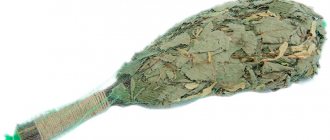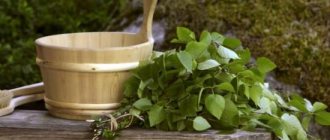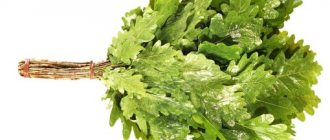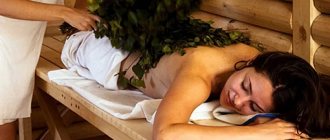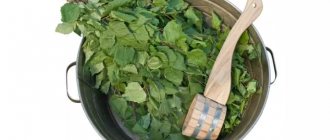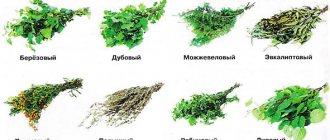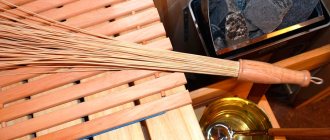In the modern world, people live in warm houses, houses with air conditioning. And a very important system of the human body, fundamental to the body, practically does not work. We are talking about a thermoregulation system that turns out to be virtually unclaimed. And only in the bathhouse does a person force her to work. The temperature and steam effects of the bath train the heart muscle, blood vessels, cleanse and rejuvenate the body. A bath is necessary at least once a week, but it must be correct. In order to prepare for a trip to it, you need to take into account many factors: what kind of broom you choose, what oils you use, depends on what effect the bath will give. This article will tell you everything about preparing for steaming, how to properly steam a broom and the advantage of a juniper broom over others.
The benefits of juniper brooms for baths
Juniper needles contain dozens of useful substances. It contains essential oils, phytoncides, antiseptic components, vitamins and organic acids.
A properly prepared broom has the following useful qualities:
Helps in relieving symptoms of joint diseases . Can be used in the treatment of arthritis, arthrosis, radiculitis, etc. Juniper helps relieve inflammation in tissues.
Heals the skin . The essential oils contained in juniper needles have a general healing and rejuvenating effect on the skin. They help fight acne and promote accelerated tissue regeneration.
Fights colds and bronchopulmonary diseases . You can use a broom for bronchitis, pneumonia, tuberculosis, etc. Essential oils have a mucus-thinning effect and suppress the action of pathogenic microflora.
Increases blood circulation in tissues . The skin becomes smoother, more elastic and well-groomed. By normalizing blood flow, the process of removing toxins and waste is accelerated.
Juniper broom has a complex effect on the entire body. Regular bathing procedures using a heather broom can boost immunity, get rid of skin diseases, cope with cold symptoms, cure ulcers and non-healing wounds.
Contraindications
Juniper broom is not recommended for use in the presence of the following conditions:
- severe skin damage, open wounds;
- pregnancy;
- diseases of the heart and blood vessels.
In addition, people with allergies to the plant will have to avoid using a broom.
A little about the plant itself
Juniper cone fruits contain large amounts of sugar. Because of this, some call the plant a coniferous grape. Berries are sometimes added to jam, honey and other drinks are brewed with them.
Juniper is the only environmental sterilizer. It is believed to produce phytoncides that destroy harmful bacteria. Previously, this factor was used for pickling cucumbers and sauerkraut. Several branches of juniper were placed in the tubs. This gave an interesting aroma to the twists and prevented any nasty things from getting in there.
When to prepare branches for a juniper broom?
Juniper is an evergreen plant, so you can collect raw materials for brooms in any season. However, depending on the time of year, the amount of nutrients in the needles and the stiffness of the branches will vary greatly.
If you want to start harvesting juniper branches, remember the following nuances:
- the highest concentration of nutrients in the needles is found in late May-early June;
- Branches should be harvested on a cool, dry day. This way the needles will fall off less;
- To create a broom, collect not only young flexible branches, but also stronger branches. They will act as the base of the broom.
Expert opinion
Lovkachev Boris Petrovich
Bath master who knows everything about steaming
Important! The ideal time for harvesting juniper raw materials for making brooms is the end of May-beginning of June. Branches with fruits are not suitable for making a broom.
Important rules for collecting raw materials
In order for the broom to be durable, beautiful and bring only benefits, you must adhere to the following rules:
Collect branches from bushes growing away from roads, power lines, city limits and factories . Do not forget that needles have the ability to accumulate toxic substances.
Take branches only from healthy plants . Do not touch bushes with signs of disease, damage from insects or chemicals.
Give preference to branches growing on the sunny side . Branches on the north side fall off much faster.
Cut branches at least 50 cm long . This is the optimal length for making a comfortable bath broom.
With proper selection and compliance with the listed rules, juniper branches will be elastic and pliable.
Juniper bushes grow slowly and take a long time to recover, so there is no need to cut off a large number of branches from one bush.
How to tie a fresh broom for a bath?
It is best to take the lower branches of the plant to make a broom. For one broom you will need 5-6 good, healthy branches.
The sequence of work is as follows:
- Before work, the collected branches should be washed with cold, clean water. This way you will wash away all the dust and dirt from them.
- After washing, place the raw materials in a well-ventilated and dry area on clean boards or newspaper and let them dry completely. It is very important that they are not exposed to sunlight. For example, the ideal place for drying may be the attic of a private house. Don't forget to turn the branches over from time to time.
- After the workpieces have dried, take several large and strong branches. Place them in the center. They will act as a base.
- Place younger and softer branches around the base, which will have a soft massage effect on the skin.
- Press the branches tightly and tie the bottom using linen rope or bast.
- Clean the bottom of the broom. Remove needles and branches that can injure your hand during bath procedures.
Juniper has fairly stiff needles, therefore, it is necessary to wear gloves when knitting a broom.
Manufacturing process
A fir broom is made from pine needles collected in sunny, dry weather. Branches whose length does not exceed seventy centimeters are suitable for these purposes. The thickest of them are placed inside the future product, surrounded by thinner twigs. It is important to ensure that the curved edges of the shoots are facing the broom. There should be no knots or small needles in the place where the handle is supposed to be placed.
During the knitting process, the branches must be placed so that you end up with a flat broom. At the end, the assembled bundle should be tied with twine or any other strong rope. This should be done in the place where the broom handle is located. Then all that remains is to trim the ends of the fir branches and wrap the handle with a bandage or cloth.
Those who do not have the opportunity to make a full-fledged fir broom can be recommended to use oil obtained from the needles of this plant. It is extracted from spruce branches using a special apparatus. At the same time, from a two-hundred-liter barrel tightly packed with fir branches, you can get only one and a half liters of oil.
For handymen, there is no point in buying a ready-made barrel, thereby overpaying for labor, brand, transportation, and so on. Craftsmen can easily make such an extraordinary design on their own.
To make a steamer, arm yourself with:
- wood planks;
- beeswax;
- rivets;
- metal hoops;
- blanks for the bottom and lid;
- rope;
- hammer;
- jigsaw;
- plane;
- grinding machine.
I think every craftsman can find such a meager set. Although, who knows...
Process
The workflow consists of the following steps:
- The bottom is being prepared - the end of the bottom is ground along the perimeter of a circle approximately 1 cm deep;
- in the prepared boards, recesses are made in the places where the bottom will be fixed, 0.5 cm deep and 1.3 cm wide (for the thickness of the bottom);
- the longitudinal sides of the blanks for the walls are processed with a plane (floor angle);
- these blanks are adjusted to each other, securely fixed around the perimeter of the bottom using the first hoop about 5 cm wide, after which the second hoop is installed in the upper part of the bucket;
- rope handles in the form of loops are attached to the sides of the product;
- then the dies for the lid are prepared and polished;
- a circle is drawn on thick cardboard according to the upper dimension of the barrel made;
- a blank is made like a bottom;
- a small hole is cut in the side of the lid for a broom;
- the lid is well polished;
- a handle is nailed on top (on the lid);
- The product is coated with wax or linseed oil.
That's all the manipulation. Is it difficult? Of course not (I know, residents of megacities did not take this seriously). To get a clearer picture of the whole picture described above, watch the video at the end of the article - it’s just interesting...
Such a product, if properly prepared and stored, can be used repeatedly. It is resistant to wear and is able to perfectly retain its properties when frozen. It is recommended to purchase finished products in specialized stores or prepare them yourself. When using the last option, it is important to know how to prepare a juniper broom for a bath correctly.
To prepare the products, you will need sharp pruning shears and gloves made of thick fabric. To keep all the needles intact, it is better to harvest in cool weather. It is recommended to cut branches from the central part of the bush. They should not be dry or crooked. For a broom, select material no more than 50 centimeters in length.
You need to wear gloves when knitting a broom. For the central part, which will serve as the basis, take thick and large branches. The middle is lined with soft, thin and fluffy twigs. The branches should fit tightly against one another, and the broom itself should be tightly tied with thread.
To obtain maximum benefits, it is allowed to combine juniper with other plants: oak, linden. In this case, all the beneficial properties will be preserved, but the product will be softer. Eucalyptus is not recommended as a supplement due to an overabundance of essential oils.
We suggest you familiarize yourself with: How to properly steam brooms for a bath: how to steam an oak broom or from other branches, how to properly soak an oak broom, how to soak
How to store juniper broom?
Juniper is a coniferous plant. You can get raw materials for making a broom at any time of the year, so there is no point in harvesting branches for use. In addition, professional bath attendants recommend using a fresh juniper broom in the steam room.
Heather brooms are not intended for drying, since when the branches dry out, the needles begin to fall off. If necessary, the finished broom can be stored at a temperature just above zero with fairly high humidity. However, the shelf life of the product in this case will be 2-4 weeks.
If you don’t have the opportunity to go for heather raw materials every time, you can freeze the finished broom. A fresh broom is wrapped in cellophane and stored in the cold or in the freezer.
The film will not allow moisture to evaporate and will keep the needles fresh. The broom can be stored in this form for 3-4 months.
Juniper brooms are the most capricious. Even with proper preparation of branches and proper freezing, such a broom can easily crumble after thawing. That is why experienced bathhouse attendants advise using heather brooms exclusively in fresh form.
Juniper species
The three most common types of this plant are:
Ordinary
It grows in the form of a multi-stemmed tree reaching a height of 18 m, as well as a spreading shrub up to 6 m. It is unpretentious and tolerates unfavorable weather conditions. It blooms abundantly and has blue-black cones. The following varieties have gained particular popularity among gardeners: Horstmann Pendula, Hibernika, Hornibrookii and NanaAurea.
Daursky
Resistant to drought and frost, completely undemanding to the soil. Most often, its decorative variety Expansa Variegata is used in landscape design. The plant is small, reaching no more than one and a half meters in height, but it actively grows in width (up to 3 m). It has beautiful light green needles with beige splashes.
Cossack
It is mainly found in the form of a low shrub with amazing scale-like needles that have a rich aroma. The list of common varieties includes: Tamariscifolia, Erecta, Variegata. They fit perfectly into the exterior of the area adjacent to the house.
Preparing a broom for use: brewing rules
Since juniper brooms have prickly needles and fairly stiff branches, they should not be used without first brewing them. They do this in two ways: soft and hard. The choice of one option or another depends solely on the preferences of the person. We'll look at both.
The hard way
When brewed using the “hard” method, the broom will retain its rigidity, the needles will remain quite hard and prickly. This broom is not suitable for hitting the body, but it can be used for a light massage, reminiscent of an acupuncture session.
So, for this you need:
- Pour boiling water over the prepared broom.
- After that, put it in cold water for 10-15 minutes.
- After the allotted time, the broom is completely ready for use.
You can also “brew” a broom in another way. To do this, wrap it in a wet, hot rag and leave it in a bathhouse on a shelf for about 1.5-2 hours.
Gentle steaming method
When steamed in this way, the broom becomes softer. It can be used for intense massage.
This is done as follows:
- Take a broom and dip it in cold water for 2-3 minutes. This way you will wash away dirt and dust from the needles.
- The prepared broom is dipped into a bucket of boiling water and kept for 30 minutes or more. Some bathhouse attendants advise steaming a broom for at least 2 hours.
- After the allotted time is up, the broom is shaken off from the water and used for its intended purpose.
Expert opinion
Yaremchuk Svetlana Sergeevna
The owner of a SPA salon knows everything about beauty treatments
The remaining water after steaming can be used to create steam. It contains many useful substances and microelements.
Massage with juniper broom
A juniper broom massage will bring the greatest benefit to people suffering from skin rashes, allergies, and pathologies of the bronchopulmonary system. Essential oils have a healing effect on all body systems, help open pores and remove toxins.
A light massage relaxes and promotes sound and restful sleep. A more intense massage gives strength and energy, energizes you. Thus, you can use a juniper broom at any time of the day.
If you want to get the maximum benefit from the procedure, remember a few rules:
- Perform a massage only on the second visit to the steam room. The first visit is necessary for the body to steam and prepare for the upcoming procedure.
- Always start the massage with the feet and work your way up the body. This way you maintain and normalize the natural flow of blood and lymph.
- The first time, use a broom for light rubbing and stroking. Pay attention to your feet, sparks, back, stomach, sides and arms.
- After this, you can move on to a more intense massage with light tapping. You can press the broom against your body by pressing it with your hand. The duration of the intensive massage should not exceed 5 minutes.
- Any massage ends with light stroking, which helps to soothe the skin.
Juniper broom is an excellent tool for bathing procedures. It saturates the steam room with a magnificent aroma and has a comprehensive healing effect on the body.
Question answer
Is it possible to hover a child’s juniper broom?
Visiting the steam room for children under 3 years of age is contraindicated. Juniper broom is highly rigid. It is not recommended for massaging children, as touching the needles to the skin can cause severe discomfort.
Is it possible to dry juniper brooms?
Juniper brooms are not intended for drying, since when dry, the needles begin to fall off the branches. In the future, it is impossible to use such a broom for massage.
How many times can you brew a juniper broom?
It is best to use a fresh broom for each visit to the steam room. However, if necessary, juniper broom can be brewed twice.
Is it possible to store a juniper broom in the house?
You can store a juniper broom in the freezer. You can also store the product in a room with high humidity or sub-zero temperatures. In winter, the broom can be hung on the balcony.
Who are juniper brooms contraindicated for?
Using a juniper broom is not recommended for people with allergies to the plant. People suffering from bronchial asthma should also use the broom with caution.
Tips for beginners
- It is better to go to the steam room together: one soars, the other takes a steam bath. Then each participant will be able to relax and enjoy the moment.
- You can’t steam on an empty stomach, but it’s also not recommended on a full one. The best time is two hours after the last meal.
- Don't get your hair wet; it's better to buy a bath cap.
- Before entering the steam room, douse yourself with warm water.
- How long you stay there is up to you, but experts advise dividing the soaring time into three or four “portions” of 10 minutes each.
- You should not use a broom for the first time - put it aside until the second time.
Many people do not know that a broom is not only a massage element, but also the main element for controlling steam. It is used to move and direct hot air towards those steaming. The choice of material here is very important, since each plant has certain properties. Brooms are made from almost everything: they come from birch and oak, fir and linden, eucalyptus and juniper. We will dwell on the latter in more detail.
